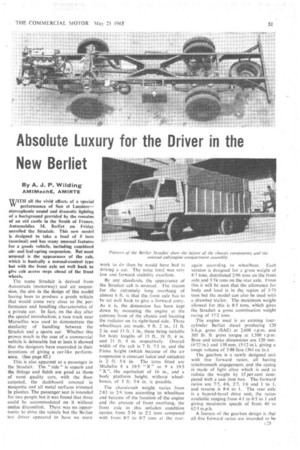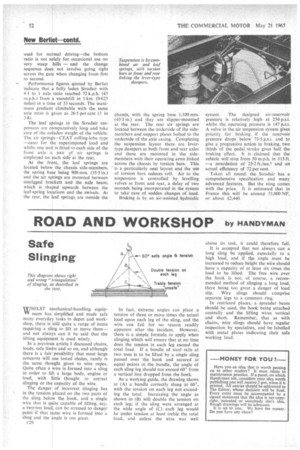Absolute Luxury for the Driver in the New Berliet
Page 53

Page 54

If you've noticed an error in this article please click here to report it so we can fix it.
By A. J. P. Wilding
AMIMechE, AM1RTE
VVITH all the vivid effects of a special performance of Son et Lumierestereophonic sound and dramatic lighting of a background provided by the remains of an old castle in the South of France, Automobiles M. Redid on Friday unveiled the Stradair. This new model is designed to take a load of 5 tons (nominal) and has many unusual features for a goods vehicle, including combined airand leaf-spring suspension. But most unusual is the appearance of the cab, which is basically a normal-control type but with the front axle set well back to give cab access steps ahead of the front wheels.
The name Stradair is derived from Autostrada (motorway) and air suspension, the aim in the design of this model having been to produce a goods vehicle that would come very close to the performance and handling characteristics of a private car. In fact, on the day after the special introduction, a race track near Marseilles was used to demonstrate the similarity of handling between the Stradair and a sports car. Whether this proves much in the case of a commercial vehicle is debatable but at least it showed that the designers have succeeded in their intentions of giving a car-like performance. (See page 62.) This is also apparent as a passenger in the Stradair. The " ride " is superb and the fittings and finish are good as those of most quality cars, with the floor carpeted, the dashboard covered in moquette and all metal surfaces trimmed in plastics. The passenger seat is intended for two people but it was found that three could be accommodated on it without undue discomfort. There was no.opportunity to drive the vehicle but the Berliet test driver appeared to have no more
work to do than he would have had in driving a car. The noise level was very low and forward visibility excellent.
By any standards, the appearance of the Stradair cab is unusual. The reason for the extremely long overhang of almost 6 ft. is that the_ front axle has to be set well back to give a forward entry. As it is, the dimension has been kept down by mounting the engine at the extreme front of the chassis and locating the radiator on its right-hand side: Three wheelbases are made, 9 ft. 2 in., II ft. 2 in. and 13 ft. l in., these being suitable for body lengths of 15 ft., 18 ft. 4 in. and 21 ft. 8 in. respectively. Overall width of the cab is 7 ft. 7.2 in. and the frame height (which because of the air suspension is constant laden-and unladen) is 2 ft. 5.4 in. The tyres fitted arc Michelin 8 x 19-5 "X" or 9 x 19.5 " X ", the equivalent of 16 in., and a body platform height, without wheelboxes, of 3 ft. 3.4 in. is possible.
The chassis-cab weight varies from 2.83 to 2-9 tons according to wheelbase and because of the location of the engine and [he amount of front overhang, the front axle in this unladen condition carries from 2-34 to 2.2 tons compared with from 0.5 to 0-7 tons at the rear, again according to wheelbase. Each version is designed for a gross weight of 8.7 tons, distributed 2.96 tons on the front axle and 5-74 tons on the rear axle. From this it will be seen that the allowance for body and load is in the region of 5-75 tons but the model can also be used with a drawbar trailer. The maximum weight allowed for this is 8.5 tons, which gives the Stradair a gross combination weight rating of 17.2 tons.
The engine used is an existing fourcylinder Berliet diesel producing 120 b.h.p. gross, (SAE) at 2,600 r.p.m. and 305 lb. ft. gross torque at 1.509 r.p.m. Bore and stroke dimensions are 120 mm. (4.72 in.) and 130 mm. (5.12 in.), giving a swept volume of 5.88 litre (361 cu. in.).
The gearbox is a newly designed unit with five forward ratios, all haying synchromesh engagement, and the casing is made of light alloy which is said to reduee the weight by 15 per cent compared with a cast iron box. The forward ratios are 7-7, 4-6, 2.7, 1-6 and 1 to 1. and reverse is 8.4 to I. The rear axle is a hypoid-bcvel drive unit, the ratios available ranging from 4.1 to 6.5 to I and giving maximum speeds of from 40 to 62.5 m.p.h.
A feature of the gearbox design is that all five forward ratios are intended to he c25 used for normal driving—the bottom ratio is not solely for occasional use on very steep hills — and the change sequence does not involve going right across the gate when changing from first to second.
Performance figures quoted by Berliet indicate that a fully laden Stradair with 9-1 to 1 axle ratio reached 72 k.p.h. (45 m.p.h.) from a standstill in I km. (0-625 miles) in a time of 53 seconds. The maximum gradient climbable with the same axle ratio is given as 26.5 per cent (I in 3-8).
The leaf springs in the Stradair suspension are comparatively long and take care of the unladen weight of the vehicle. The air springs--CEAT rolling-lobe type —cater for the superimposed load and whilst one unit is fitted to each side of the front axle a pair of air springs is employed on each side at the rear.
At the front, the leaf springs are located below the chassis side-members, the spring base being 900 mm. (35.5 in.) and the air springs are mounted between outrigged brackets and the axle beam, which is shaped upwards between the leaf-spring locations and the swivels. At the rear, the leaf springs are outside the chassis, with the spring base 1,100 mm. (43-3 in.) and they are slipper-mounted at the rear. The rear air springs are located between the underside of the sidemembers and support plates bolted to the underside of the axle casing. Completing the suspension layout there are levertype dampers at both front and rear axles and these are mounted in the sidemembers with their operating arms linked across the chassis by torsion bars. This is a particularly neat layout and the use of torsion bars reduces roll. Air to the suspension is controlled by levelling valves at front and rear, a delay of two seconds being incorporated in the system to take care of sudden changes of load.
Braking is by an air-assisted hydraulic
system. The designed air-reservoir pressure is relatively high at 250 p.s.i. whilst the operating pressure is 147 p.s.i. A valve in the air suspension system gives priority for braking if the reservoir pressure drops below 73-5 p.s.i. and to give a progressive action to braking, two thirds of the pedal stroke gives half the braking effect. It is claimed that the vehicle will stop from 50 m.p.h. in 115 ft. —a retardation of 23-2 ft./sec.2 and an actual efficiency of 72 per cent.
Taken all round. the Stradair has a comprehensive specification and many advanced features. But the sting comes with the price. It is estimated that in France this will be around 33,000 NF, or about £2,940.
























































































































